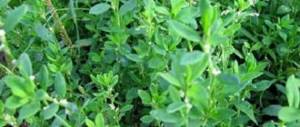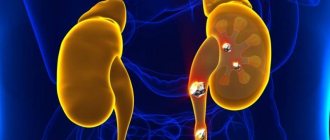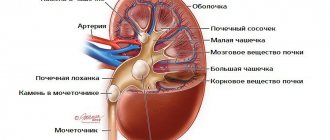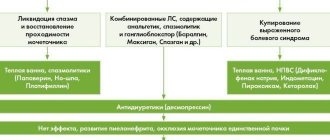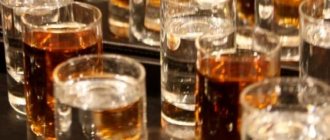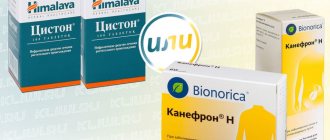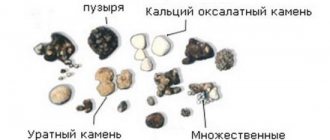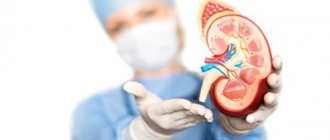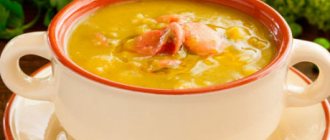Madder herb and its composition
Moraine is presented in the form of a herbaceous perennial plant with a horizontal rhizome and branched shoots, the height of which can reach about two meters. Milena or madder grows along river banks, irrigation canals, on forest edges or in abandoned gardens, and even along fences. The plant itself loves warmth and moisture, so in dry and windy climates it practically does not bear fruit.
Despite its unpretentiousness, heart-leaved kel (madder) is characterized by a rich biochemical composition:
- Pectin;
- Ascorbic acid;
- Carbohydrates;
- Proteins;
- Acids of organic origin (tartaric, malic, citric);
- Rutin;
- Sahara;
- Phenolcarboxylic acids;
- Iridoids, etc.
Thanks to this composition, madder acts as an antispasmodic and also has therapeutic effects: increasing the acidity of stomach juice; reduction of pain during urination; reduction of kidney pain. The use of madder can reduce tone and increase muscle contractions of kidney peristalsis, as well as improve water-salt metabolism.
Chemical composition of common raspberry
The rhizomes of the plant contain organic acids (citric, malic, tartaric), triterpenoids, anthraquinones (ruberythric acid, haliosin, purpurin, purpuroxanthin, pseudopurpurin, rubiadin, ibericin and rubiadin, as well as alizarin in the free state) - 5-6%, iridoids, sugars, proteins, pectins and ascorbic acid. In the aerial part, carbohydrates, iridoids, phenolcarboxylic acids and their derivatives, coumarins, flavonoids (quercetin, kaempferol, apigenin, luteolin, etc.) were found; in the leaves - iridoids and flavonoids; in flowers - flavonoids rutin and hyperoside.
The rhizomes and roots of madder contain: ash - 11.30%; macroelements (mg/g): K - 28.80, Ca - 19.30, Mn - 1.90, Fe -2.50; microelements (CBN): Mg - 0.43, Cu - 1.71, Zn - 1.43, Co - 0.04, Cr - 0.65, Al - 0.50, Ba - 2.01, V - 0 .46, Se - 0.50, Ni - 0.63, Sr - 0.60, Pb - 0.13, I - 0.09. B - 43.60 µg/g. Mo, Cd, Li, Au, Ag, Br were not detected. Concentrates Fe, Cu, Zn, Cr, Ba.
What are the benefits of madder root?
For medicinal purposes, Kelba roots are usually used, which are obtained in the fall or spring, thoroughly cleaned, and then dried at a temperature of no more than 50 ° C.
Medicines containing madder can be presented in the following forms:
- Decoction;
- Pills;
- Powder;
- Extract;
- Herbal tea;
- Drops;
- Tincture.
It is worth noting that the range of indications for the use of madder for medicinal purposes is quite wide, so it can be used for diseases of the digestive, urinary and respiratory systems, as well as for the treatment of skin diseases.
Thus, the following diseases may be indications for the use of madder::
- Stones in the kidneys;
- Rickets;
- Skin cancer;
- Dermatomycosis;
- Gout;
- Pigmentation;
- Osteomyelitis;
- Intestinal or bone tuberculosis, etc.
User reviews indicate that the use of madder has shown the greatest effectiveness for kidney stones, since the plant not only helps remove stones, but also destroys the primary causes of their appearance.
Medicinal raw materials of madder
The rhizomes and roots of madder are dug up in the fall with a shovel. Dug up rhizomes should be shaken off the ground. They are washed only as a last resort, if the soil is clayey and wet, and there is no way to shake it off. The finished raw materials are dried at a temperature of 45-50°. The shelf life of raw materials is 3 years for medical purposes, and longer for dye production. Freshly dug roots are yellow, and only after drying do they turn red.
Madder dyeing, excavation of raw materials
Where is madder used?
Initially, marengo was grown only for industrial purposes, especially those varieties that can be used to produce fabric dyes, usually red dye. However, in recent times, madder is used less and less in industry and more and more in medicine.
Medicinal use of madder provides anti-inflammatory and antibacterial effects.
The medicinal composition of the plant provides relief from pain, stopping bleeding and faster healing of wounds of the urinary tract.
In addition to these actions, reviews indicate that madder can have:
- Antiallergic effect;
- Sweatshop;
- Antipyretic effect;
- Antitoxic effect;
- Anticonvulsant and astringent effect.
At home, Kelba is used in the form of an infusion or decoction. The decoction is used for external use, as compresses on the skin, prepared as follows: madder roots (about 10-12 g) are poured with 100 ml of water and boiled in a water bath for about 15 minutes, after which the liquid is cooled and filtered.
Madder root tincture is prepared a little differently:
- About 200 ml of water should be heated to approximately 85 degrees, without boiling;
- Approximately 19-20 g of dried and pre-crushed plant roots are added to hot water;
- For two hours, the liquid is infused under a closed lid and then filtered;
- The resulting infusion is taken after meals, 75 ml.
By the way, a ready-made tincture of madder roots can be purchased at a pharmacy.
Medicinal properties of the plant
Today, this natural dye is more used as a medicine in modern medicine due to its pronounced litholytic, diuretic and antispasmodic effects.
Due to its amazing properties, medicinal forms of madder loosen phosphate, urate and oxolate salt deposits (calculi) in the kidneys.
They also contribute to the painless removal of their breakdown products from the body, enhancing contractions of the muscles of the urinary tract.
They exhibit moderate bactericidal properties against pathogens of gonococcal infections. Salts are washed away from synovial joints (gout, radiculitis, osteochondrosis).
Madder is also characterized by antibacterial and anti-inflammatory effects. Resists the development of secondary bacterial infection in chronic inflammation of the genitourinary system.
Beneficial properties of madder extract
One of the forms of use of madder is its extract, which is used primarily for the treatment of urolithiasis. The pharmacological properties of the extract include loosening and disintegrating kidney stones, removing “sand” from the kidneys and relieving pain symptoms.
The drug itself is presented in the form of tablets, which are available in 10 or 20 pieces per package.
The course of treatment should be about a month (20-30 days), and re-treatment is prescribed by a doctor no earlier than after 1.5 months.
The course of treatment involves taking 1 tablet three times a day; in special cases, 2 or 3 tablets three times a day may be prescribed. First, the tablet is dissolved in half a glass of warm water and taken orally.
It is worth noting a number of features of the use of madder extract:
- During treatment, a person's urine turns red.
- If a brownish-red tint of urine appears, you should immediately consult a doctor, who will reduce the dosage or stop the course for some time.
- An overdose of the drug can manifest itself in the form of pain that appears when stones and other concretions pass.
It is not recommended to prescribe a course of treatment on your own; it is better to consult a doctor who will tell you exactly how much and how to take this drug.
Dietary supplements and homeopathy for kidney stones
- 1 What is the advantage of treating kidney stones with dietary supplements? 1.1 Additives “Prolit” and “Prolit Super”
- 1.2 "Kedjibeling extra"
- 1.3 "Ginjaleling"
- 1.4 "Litovit-U"
- 1.5 "Vision Nutrimax"
- 3.1 Features of homeopathic treatment
Medicine of the 21st century uses dietary supplements for the kidneys based on medicinal herbs for treatment. Such drugs saturate the body with useful substances, help in the treatment of the urinary system, and act as a preventive measure. Despite the prejudice against such medications, dietary supplements are indispensable in Ayurveda and homeopathy.
Have you been fighting CYSTITIS for many years without success?
Head of the Institute: “You will be amazed at how easy it is to cure cystitis by taking it every day...
Read more "
What is the advantage of treating kidney stones with dietary supplements?
Human nutrition and lifestyle have changed over the past 100 years compared to other eras. As a result, a number of diseases arise, including kidney stones. This diagnosis is due to poor nutrition, therefore dietary supplements for the kidneys are a solution that has become an impetus for the recovery of modern patients. Of course, complication or exacerbation of the disease requires other treatment methods. However, as an adjuvant or for prevention, dietary supplements for the kidneys will affect the reduction in the size of stones and excretion from the kidneys.
Dietary supplements for kidney stones demonstrate the following benefits:
- convenient and safe to take;
- almost no cases of complications;
- no contraindications;
- You can take such supplements for kidney treatment for a long time.
Return to contents
Additives "Prolit" and "Prolit Super"
This drug is made from raw materials of plant origin.
This drug is said to be both inexpensive and effective for kidney stones. The basis of the dietary supplement is made up of natural herbs that have a beneficial effect on the kidneys:
- a concentrated extract of kidney tea leaves is a natural diuretic used for centuries to treat kidney diseases;
- leaves of the sow thistle plant - tones the urinary canal;
- leaves of the curly mulberry bush, also known as kedjibeling, which has an antioxidant effect, the plant removes stones and improves natural protection;
- papaya (or melon tree leaves) relieves swelling and improves microcirculation in inflammatory areas;
- Phyllanthus niruri herb with antiseptic properties helps dissolve kidney stones; the roots of the Alpinia officinalis plant have an anti-inflammatory effect;
- the roots of the imperata cylindrical plant act as a diuretic, as well as a hemostatic agent; cubeba pepper contains an antibacterial and anti-inflammatory substance;
- The peel of the fruit of garcinia mangosteen reduces cholesterol and fatty acids, normalizes the metabolic process.
Return to contents
"Kedjibeling extra"
This is a special dietary supplement that improves the functioning of the urinary system. The basis of the supplement is the plant pearl of Indonesia, a unique creation in the world of flora - kejibeling or curly silkworm. The very special properties of dissolving stones in the kidneys, gall bladder and urinary tract have made kejibeling famous all over the world and the main component of several hundred dietary supplements. It is also used as a prophylactic to prevent inflammatory processes. Renal colic decreases during the period of use of the drug. Contraindications apply to two cases: during pregnancy and breastfeeding.
Return to contents
"Ginjaleling"
A prophylactic drug for the treatment of kidney stones is an antispasmodic herbal remedy.
Ginjaleling has become a sensation in the medical treatment of kidney stones. Long-term use of such a drug for prevention is completely safe. The absence of an inflammatory process, the removal of sand and stones, and a decrease in the severity of renal colic are the result of the action of the nutritional supplement. The dietary supplement is available in capsules so that the patient can take the capsule orally and wash it down with water.
Return to contents
"Litovit-U"
The composition of “Litovit-U” includes the herbaceous plant madder, which is able to loosen kidney stones and promote their movement from the urinary tract. It is recommended to take 1.5-2 grams twice a day, every two hours, with water. "Litovit-U" has the following properties:
- normalization of mineral metabolism;
- Dietary supplements are a source of micro- and macroelements that a person needs;
- alleviating effect on urolithiasis;
- the likelihood of complications decreases;
- proven anti-inflammatory properties.
Return to contents
"Vision Nutrimax"
The mineral-vitamin complex “Vision Nutrimax” is aimed at powerful antiseptic, antimicrobial and diuretic effects. Among other drugs, it stands out for its gentle and gentle removal of large stones and sand from the kidneys. The complex is also ideal for prevention for people prone to the disease. The properties of dietary supplements include:
- easily removes small stones from the kidneys;
- qualitative improvement in the functioning of the genitourinary system;
- prevention of diseases of the genitourinary system, in particular, prevents the formation of new stones and sand;
- destroys infection;
- fights puffiness, including facial puffiness;
- good diuretic;
- antibacterial agent;
- saturates the body with calcium and iron, acting at the cellular level.
Return to contents
Ayurveda remedies for kidney stones
Both individual herbs and Ayurvedic preparations are effective in treating urolithiasis.
In Ayurveda, the disease of kidney stones is called Vrukka Ashmari. Treatment is aimed at using drugs that can dissolve stones, and then tone and strengthen the body. If sand or stones have already formed, we recommend paying attention to proven Ayurvedic preparations:
- Ashmarihar Ras is an Ayurvedic combination of herbs that dissolves gallstones. The drug removes various types of toxic substances from the body, rejuvenates the blood, and stops the formation of new kidney stones. Stones pass safely through the urinary tract.
- Vrikkdoshar Vati is an Indian dietary supplement in tablet form. Regulates renal functions, balances hormones, filters waste products at the cellular level and removes them from the body. Helps people suffering from recurrent kidney infections. Safe for long-term use.
- "Trikuntak" is a herbal remedy with a minimum course of use of one month. Strengthens kidney function, acts as a rejuvenating tonic. This is a stone-dissolving drug that washes away and removes sand and kidney stones, treats swelling and inflammatory processes in the genitourinary system.
- “Gokshuradi guggul” is an Ayurvedic dietary supplement that enhances the treatment of urinary systems and kidney function. Application provides better urination, removal of stones from the kidneys, cooling of the mucous membranes of the ureter. The drug also rejuvenates the reproductive system. As a result, the three doshas are balanced.
Return to contents
Homeopathy and treatment of urolithiasis
Homeopathic treatment is usually accompanied by a special diet.
Such alternative treatment must be agreed with your doctor. The peculiarity is that the patient follows a certain diet (foods with purines are excluded) and follows the rules of treatment. If the urine contains oxalates, the patient should not take sorrel, and if phosphate stones are found, restrictions apply to dairy products.
Return to contents
Features of homeopathic treatment
The main rules to follow are:
- Dietary supplements should not be mixed with food. Tea, lemonade, coffee, juices are also food and should not be mixed with medications.
- Reduce the amount you drink as much as possible.
- Caffeine, like mint toothpastes and mint chewing gum, neutralizes the beneficial effects of homeopathy and should be excluded from the diet.
- The drugs are stored in a separate cabinet, as far as possible from electrical appliances, thus preventing exposure to electromagnets.
- You cannot take dietary supplement granules with your hands, only using a clean napkin.
Return to contents
To treat cystitis, our readers successfully use Galina Savina’s method
This cheap odorous remedy will get rid of cystitis forever! Sold in every pharmacy, called...
Homeopathic medicines
To slow down and also prevent the appearance of stones, we recommend choosing the right homeopathic remedies depending on your constitution:
- "Renel" is an ideal homeopathic substance recommended for use for urolithiasis. Suitable as an auxiliary drug. Important - do not pick it up with your hands, only with tweezers, as it is easy to scatter the capsules.
- “Berberis” is the main substance in homeopathy that can disrupt protein metabolism for the formation of stones in the gall bladder and kidneys.
- "Populus compositum" is a diuretic used for nephritis, cystitis, urolithiasis, prostatitis, prostate adenoma.
- "Solidago compositum" - increases the excretory function of the kidneys in chronic diseases and urinary incontinence.
Dietary supplements are actively used in both traditional and alternative medicine (Ayurveda, homeopathy). The main task is to make the right choice of a nutritional supplement that will help everyone individually with maximum effect. This choice may take some time, but the result will be worth waiting for: relief of inflammatory processes, painless removal of stones and sand, improvement of the functionality of the entire system.
Contraindications and instructions: madder dye
In addition to the extract, madder is taken in the form of herbal tea, which includes other medicinal plants. The course of herbal tea treatment is about a month; for this, a tea bag is brewed and infused for 4-5 minutes, and taken once in the evening, an hour after dinner.
Madder in drops helps relieve swelling and dissolve calcium oxalates, removing them from the body. Drops are taken for a month, twice a day, 20 drops dissolved in 150 ml of water.
The most common drug containing moraine is cystenal in the form of drops. It is used to treat cystitis and urolithiasis, when secondary inflammatory changes or spasms occur. Taking the infusion continues for a month, three times a day, 3-5 drops dissolved in water, 20-30 minutes before meals. If the patient has increased acidity of the gastric juice, then the drug is taken during and after meals, and if the acidity is reduced, then it is necessary to take medications together with hydrochloric acid or pepsin.
Like any other drug, madder can have side effects:
- Allergic reactions;
- Exacerbation of chronic inflammation;
- The appearance of pain;
- Nausea;
- Diarrhea and loose stools.
In addition, medications containing madder have contraindications in the form of: chronic or acute phase of glomerulonephritis; stomach ulcer; hypersensitivity to the components of the drug; severe renal failure; lactase deficiency. The use of this drug is contraindicated in pregnant and breastfeeding women. The course of treatment must strictly comply with the instructions or prescription of the doctor.
It is worth noting that madder is used to treat urolithiasis not only in people, but also in pets, in particular, cats. The dosage of the drug is prescribed by the doctor, it can be calculated according to the weight of the pet (per 1 kg - 1 ml). The required dose of the drug is diluted in water and given to animals twice a day for a month using a medical syringe without a needle.
Features of the diet when treating with madder
The diet should be rich in vitamins of group B and group A.
Throughout the entire course of treatment with medicines based on madder, you should adhere to a special diet.
First of all, it is necessary to limit the consumption of foods containing citric and oxalic acid. Sorrel, rhubarb, figs, purslane, barberry, cranberries, raspberries and strawberries contain these acids in abundance. It is also necessary to exclude cocoa, chocolate, various sour sauces, marinades, spinach, and citrus fruits from the diet.
The diet should be rich in vitamins of group B and group A. For example, pears, sour apples, plums, watermelon, melon, beets, cucumbers, vegetable oil, boiled or steamed cereals and other products.
Description of the species
Madder is a very tall plant (up to two meters) that is classified as a perennial and has a very powerful root system. The main root is very large, thick rhizomes extend from it. The root bark is brown in color and peels off easily. Actually, this plant is valued for its root and its extremely valuable qualities.
The plant is distinguished by an unusually thin tetrahedral rough stem, which branches very strongly, forming lush thickets. Madder leaves are dense, oblong, form whorls containing up to six leaves. Madder flowers are not too flashy, small, yellowish in color, growing in bunches at the ends of stems and twigs.
Madder flowers can be seen from June to September, and fruits from August to November. Madder fruit is a black drupe with juicy pulp. The juice of madder berries is almost impossible to wash off, and they recolor everything they come into contact with a dark wine-red hue.
Madder is a heat-loving plant, so it is found mainly in regions with a mild, warm climate. Despite its love for warm climates, madder easily takes root in almost any type of soil.
